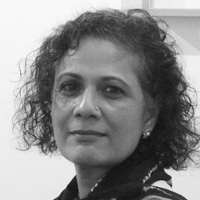In this age of the internet, we have a group of artists presented as ‘Neti-netizens’. Curated by Girish Shahane at Gallery Threshold, these ‘Vanguards’ bring forth a legacy that produces meditative imagery, which differs refreshingly from the populist present-day avant-garde expression.

They are not contemplating the divine in an abstract sort of way nor are they seeking to define the pulsating energy atoms behind all creation, instead they meditate upon seemingly mundane objects of everyday living. Thus rooted, Prajakta Potnis uses careful brushwork; painting with the kind of attention to detail Rembrandt gave to ruff collars in his 17th century self-portraits, creating light and luminous works. Yashwant Deshmukh takes simple objects breaking them down to bold geometric forms, while Madhav Imartey’s fascination with a typewriter or cement mixer gives us renditions of the object’s form and its reality beyond this and Parag Tandel explores the line as representation and evolution of thought. In leaving his hand free to discover what it will, he brings forth a network of dense lines that are dark and foreboding. Thus in their individualistic ways, they arrive at individual interpretations of reality.

The idea of such consideration being given to facets of being that are not glamorous or overtly celebrated, but intimate and personal is indeed charming. Potnis draws a single rail with a carelessly hung, bunched-up towel with residual body hair, using acrylic and dry pastel on paper. The handling of the object is detailed to the point of realistically painting each hair caught on the pile of the fabric and everything else that may have been in the space around this is erased. Her focus is only on the towel where one assumes the rail is nailed onto a wall, but it could well be floating in space. She does the same with the sofa-bed, where you can see every stitch, pinch and tear of the mattress, but it has a certain lightness of being, where defying gravity it levitates.
Using acrylic and charcoal on paper Deshmukh takes a bottle or cone, simplifying the form to the extent of distorting perspective by creating a flat surface out of 3 dimensional articles, belying the physical reality of these objects, as we have seen and felt and known them to be. In doing so, he appears child-like and one could dismiss the work as rough and un-finessed, but in this age of technology this naïve representation is curious and therefore questioned. Unlike Potnis, this austere interpretation does not please in a sensual way. Its extreme simplicity is evocative of peeling the peripheral layers of intellectualization to get to the kernel of the object’s existence, but removed in texture, form and colour from the lushness of the contemporary material world, its appeal is not spontaneous but intellectual which defies its own objective.
In de-selecting details and perspective or elements that constitute the larger environment, most art works in this exhibition seem to eliminate [or exaggerate] sensory vibrations of the physical world from which they draw upon for their reference and inspiration. This creates scope for misinterpretation of the context of their existence and yet there is a certain uncanny, unquantifiable resonance with the world we inhabit. It is this almost paradoxical nature that engages; where I am intrigued but not comforted by these explorations of the possibility of achieving inner stillness amidst internet connectivity and urban street sounds. Prajakta Potnis succeeds the most, for her simple and straightforward works have a visual pleasantness evocative of the sensual world and she also achieves the objective of meditation where in her single-minded focus the articles under consideration levitate, but I am tempted to question this effortless achievement in a world weighted with desire and the frenzy to achieve. All the works together present various dimensions of this spiritual quest but in isolation none has seemingly explored it with authenticity and conviction.
‘Legacy-A vanguard’, Prabhakar Barwe, Madhav Imartey, Yashwant Deshmukh, Prajakta Potnis and Parag Tandel, curated by Girish Shahane, Gallery Threshold, New Delhi, January-February 2010.














